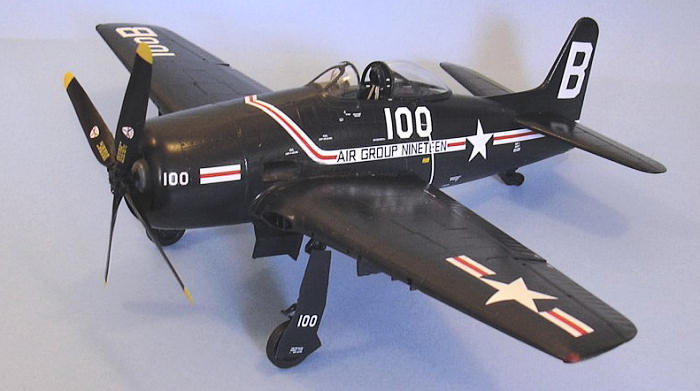
Trumpeter 1/32 F8F-1 Bearcat
| KIT #: | 02247 |
| PRICE: | $84.95 MSRP |
| DECALS: | Two options |
| REVIEWER: | Tom Cleaver |
| NOTES: | New mold kit |

| HISTORY |
Everyone who ever flew a Bearcat loved it. Legendary British test pilot Captain Eric Brown recalled that when he was assigned to the Naval Air Test Center at NAS Patuxent River, Marion Carl would do loops on takeoff, landing back on the runway out of the loop, in a Bearcat, it had that much excess power. Brown himself couldn’t decide whether he liked the Bearcat more than the Sea Fury, but definitely considered the F8F to be the best American piston-engine fighter he ever flew. Carl himself told me in 1992 that the Bearcat was his favorite airplane ever for the sheer joy of flying. The first man on the moon, Neil Armstrong, flew Bearcats when he went through U.S. Navy advanced training, and to this day considers it the most exciting airplane he ever flew. Corky Meyer, who flew every airplane Grumman ever made from the F4F onward, liked the Bearcat best.
As
Meyer explained it to me several years ago, the Bearcat was the offspring of the
marriage of a Gee Bee to a Focke-Wulf Fw-190. Bob Hall, who designed the F8F,
had come to Grumman from working with the Granville Brothers, where he had an
important hand in the design of the Gee Bee racers. As such, he was a strong
advocate of putting the biggest, most powerful engine available into the
smallest airframe that could carry it. In 1943, Hall test-flew an Fw-190A-5,
which he immediately fell in love with
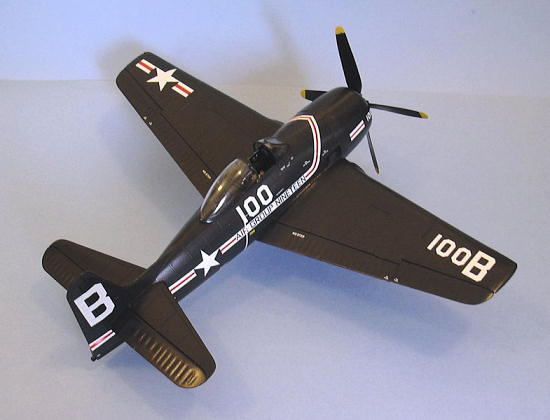 for its marvelous handling
abilities. He returned to Bethpage and wrote a memorandum to Leroy Grumman,
describing an idea for a small, high-powered, highly-maneuverable fighter. Mr.
Grumman liked the idea so much it immediately became Grumman Design Number 58.
for its marvelous handling
abilities. He returned to Bethpage and wrote a memorandum to Leroy Grumman,
describing an idea for a small, high-powered, highly-maneuverable fighter. Mr.
Grumman liked the idea so much it immediately became Grumman Design Number 58.
As it turned out, Hall was pulling an idea out of the Zeitgeist. The Fighter Desk at the Bureau of Aeronautics was staffed by former fighter pilots who had cut their teeth on airplanes like the Boeing F4B-4 - of which it was said it was so maneuverable a pilot could turn it by sticking his arm out of the cockpit - and the Grumman F2F and F3F fighters. While everyone was happy with the Hellcat, which was just embarking on its career of scything the Japanese out of the skies over the Pacific, everyone wished they were dealing with a smaller, lighter, more high-powered fighter that could take on the Japanese fighters and out-fly them.
Hall began with the Pratt and Whitney R-2800, the finest radial engine ever built, and designed the smallest possible airframe that could carry the engine. The G-58 was a “copy” of the Fw-190 in design philosophy, though no part of the German fighter was actually copied. The engine was closely-cowled in the manner of the Wurger, and had a wide-track undercarriage that greatly eased carrier landings. The new airplane also bettered the outstanding visibility of the German fighter through the use of a “bubble” canopy that was so perfectly designed it did not create drag.
The end result was 20% lighter than a Hellcat, with a 30% better climb rate, and a top speed 50 mph faster, with outstanding maneuverability. The first prototype was ordered in November 1943 and flew on August 21, 1944. The XF8F-1 was the star of the fighter competition held at NAS Patuxent that October, where it outflew everything it went up against, including the Spitfire XIV and P-51H, flying rings around the captured A5M5b Zero in attendance. Every experienced test pilot who flew it loved it. The only design change between the prototype and the production aircraft was a dorsal fillet for increased directional stability.
The Navy ordered 2,023 F8F-1s immediately after the competition, while the
prototy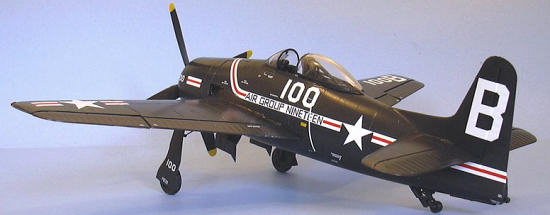 pe underwent carrier
trials in February 1945. The new fighter was small enough to operate from
escort carriers and was seen as a replacement for the venerable FM-2 Wildcat, as
well as a major fleet defense fighter against the increasingly-dangerous
Kamikaze attacks.
pe underwent carrier
trials in February 1945. The new fighter was small enough to operate from
escort carriers and was seen as a replacement for the venerable FM-2 Wildcat, as
well as a major fleet defense fighter against the increasingly-dangerous
Kamikaze attacks.
In March 1945 VF-18 and VF-19 were commissioned on Bearcats and underwent intensive training to prepare them for combat in the coming invasion of Japan, scheduled at that time to begin in October 1845 with the invasion of Kyushu. Fortunately for the world and unfortunately for the Bearcat, the war came to an end while VF-19 was in transit to the Western Pacific, and the F8F just missed combat in the war it was designed for.
The Navy canceled nearly every production contract following V-J Day, other than for the F8F-1 Bearcat and the F4U-4 Corsair. While the numbers were cut from 2,023 to around 1,200, the F8F was still the major Navy fighter and in the next two years it equipped no less than 24 squadrons. In 1946, an unmodified F8F-1 set a time-to-climb record - including a takeoff run of 115 feet - getting to 10,000 feet in 94 seconds, a record that stood for ten years until it was broken by a jet fighter, which was unable to match the Bearcat's takeoff performance. In tests with a P-80 assigned to Patuxent River in 1946, the Bearcat’s takeoff performance was such that it took off and made two firing passes on the jet before the P-80 lifted off. However, in air-to-air combat, the writing was on the wall: the Bearcat was unable to keep the jet in its sights long enough to score a hit, and was completely outperformed in speed and climb at altitude, only besting the jet in turning and roll rate.
The performance of the Bearcat was still so outstanding that the airplane replaced the Hellcat when the Blue Angels Air Demonstration Team was made a permanent organization in 1948, and flew with the team for two seasons until replaced by the F9F-2 Panther.
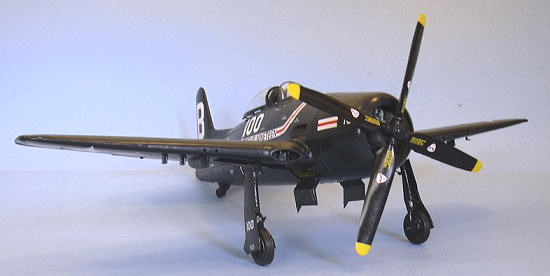 Bearcats went to the Navy
Training Command beginning in 1949, where guys like Neil Armstrong were
introduced to high performance flight. They equipped Naval Air Reserve
Squadrons starting in 1950 and were common sights at such places as NAS Buckley
Field in Denver until at least 1955, when yours truly saw his first Bearcat
sitting by the taxiway on the day I got to see the Blues make their last
demonstration in F9F-5 Panthers, and see an F7U-3 thrill the crowd with low
speed high-AOA passes along the runway. The Bearcat was more personally
interesting, since I managed to sneak over and actually touch it.
Bearcats went to the Navy
Training Command beginning in 1949, where guys like Neil Armstrong were
introduced to high performance flight. They equipped Naval Air Reserve
Squadrons starting in 1950 and were common sights at such places as NAS Buckley
Field in Denver until at least 1955, when yours truly saw his first Bearcat
sitting by the taxiway on the day I got to see the Blues make their last
demonstration in F9F-5 Panthers, and see an F7U-3 thrill the crowd with low
speed high-AOA passes along the runway. The Bearcat was more personally
interesting, since I managed to sneak over and actually touch it.
In 1964, the Bearcat began a second career as an air racer, when air racing was revived at Reno. Mira Slovak won the first race, and the sport was dominated through the end of the Sixties and the early Seventies by Darryl Greenamyer and his highly-modified Conquest I, with which he had beaten the world piston engine speed record held for 30 years by the Me-209R. Perhaps the best-known racing Bearcat of the period was Lyle Shelton’s “Rare Bear,” which has been continually modified over the years. Shelton beat the 1946 time-to-climb record in 1972, climbing to 10,000 feet in 91.9 seconds. Powered by an R-3350 swinging a Skyraider prop, the Bear set a world piston-engine speed record of 528.33 mph in 1989.
Today, there are ten Bearcats still flying in the world. It is still the most exciting piston engine airplane a pilot can strap on.
| THE KIT |
The Bearcat has been popular with plastic kit manufacturers for more than 40 years. Testors released their 1/48 F8F-2 Bearcat in 1967 and it was the standard for 1/48 kits for 30 years. Monogram released a 1/72 F8F-1 in 1969 that is still accurate, though one would have to scratchbuild a cockpit and the accessories section that can be seen in the wheel well. Frog also produced a Bearcat in the early 1970s. Hobbycraft brought out a series of Bearcats starting in 1997 that only bested the old Testors kit by having a better cockpit, though its outline accuracy left something to be desired. In 1/32, both Combat Models and ID Models released vacuformed kits that are primarily shells to be filled with the modeler’s scratchbuilding prowess.
This new Bearcat from Trumpeter beats them all. The kit has 366 parts on 11 trees, with two additional trees in clear plastic, rubber main gear tires and a photo-etch fret that includes an instrument panel face and seatbelt and shoulder harness. This last bit is best replaced with the Eduard photoetch US seatbelts, which are far easier to use and more realistic in their final look.
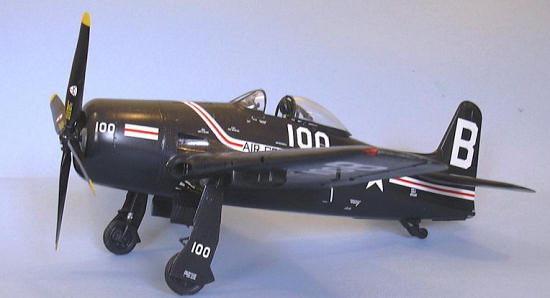 There appear to be at least two different designers doing kits for Trumpeter.
This Bearcat is the product of the designer who did the MiG-3, the TBF/M
Avenger, the SBD Dauntlesses, the Me-262s and the P-47s. Surface detail is
similar to these other kits, with equally-accurate overall shape and outline.
On this basis, I would declare the Trumpeter Bearcat the best kit of this
airplane in any scale.
There appear to be at least two different designers doing kits for Trumpeter.
This Bearcat is the product of the designer who did the MiG-3, the TBF/M
Avenger, the SBD Dauntlesses, the Me-262s and the P-47s. Surface detail is
similar to these other kits, with equally-accurate overall shape and outline.
On this basis, I would declare the Trumpeter Bearcat the best kit of this
airplane in any scale.
Decals are for two airplanes: the F8F-1 flown by the Commander of Air Group 19 in 1947, and a Bearcat flown by a Naval Reserve Squadron at NAS Akron in the 1950s. The former is done from well-known photos taken of the original while it was at NAS Alameda by Bill Turner, while the latter is done from the color three-view in the old Profile Publication Number 107, complete with the incorrect yellow Air Reserve band.
The CAG-19 decals are incorrect in that they include a “NAVY” decal for the lower wing, when it should be “100-B” (as Bill told me when I asked); all Naval carrier-based aircraft carried the modex on the lower wing until 1950, when it was replaced by NAVY. The Air Reserve band can be painted orange and masked over without difficulty, and the rest of those decals for the Akron Bearcat are accurate.
Additionally, the wing insignia for the CAG-19 airplane is too small, though that is correct for Bearcats in the 1950s. I was able to replace the wing insignia on my model with an extra set of decals from my Fisher Panther, which were the right size. I was also able to cobble together the lower wing modex using leftover Fisher Panther decals.
Pointing out the mistake on the CAG-19 Bearcat’s markings is not a complaint, since the available photos were taken from the ground, and do not include photos where the wing markings are visible; Trumpeter made a “best guess” and many modelers may use those markings with no one complaining about them - I only knew what was right because I could ask my old friend Bill Turner what he remembered. I do know that at least one aftermarket decal manufacturer is planning to do decals for the Bearcat, so this problem may be solved soon. Otherwise, these are among the best Trumpeter decals, with the white areas completely opaque when applied over Glossy Sea Blue and are well-printed.
I also know that at least one decal manufacturer is planning to do decals for all the “stock” Bearcats that have raced at Reno; since these were all F8F-2s, none of these decals would be right for this kit. I do believe at least one company will do decals for the Gulfhawk IV, which was an F8F-1 and would be right for this kit.
| CONSTRUCTION |
 In kit design, the model
presents no construction difficulties. The various panels that can be displayed
open also can be displayed closed without any pushing and shoving to get them
into position. The separate controls will fit in the neutral position for
ailerons and elevators and the up position for the flaps, though it is not
difficult to modify the attachments to display them more dynamically if one
wishes. The various panels for the accessories section and the gun bays will
allow a modeler who wants to detail these areas to show them off, while what is
there in the box for these sections is a very good starting place for
super-detailing. The cowling, which finally has the accurate shape for the
Bearcat, is molded clear and could be left such to display the engine.
In kit design, the model
presents no construction difficulties. The various panels that can be displayed
open also can be displayed closed without any pushing and shoving to get them
into position. The separate controls will fit in the neutral position for
ailerons and elevators and the up position for the flaps, though it is not
difficult to modify the attachments to display them more dynamically if one
wishes. The various panels for the accessories section and the gun bays will
allow a modeler who wants to detail these areas to show them off, while what is
there in the box for these sections is a very good starting place for
super-detailing. The cowling, which finally has the accurate shape for the
Bearcat, is molded clear and could be left such to display the engine.
The engine provides the parts to do both the R-2800-34W that the F8F-1 used, and the R-2800-30W used by the F-8F-1B and the R-2800-57C used by the F8F-2. Trumpeter has been doing the R-2800 for quite awhile now, and the engine makes up so nice that it is a model itself. To avoid confusion with the plethora of detail parts for the different sub-types of engine, a modeler need only look at the parts used for the “standard” engine in the instructions, which makes up as the 34W.
The accessories section, which is seen through the open gear wells, is well-appointed and can be assembled right out of the box to “look right”, though a modeler could include electrical wiring and such.
It is important here to note that Trumpeter’s painting instructions are incorrect. I checked with my old friend Corky Meyer, who has been around more Bearcats than anyone else alive. He told me that the interior of the cowling and the accessory section is Zinc Chromate, with a yellow water tank, while the gear wells in the wing, the gear and the gear doors, were all Glossy Sea Blue.
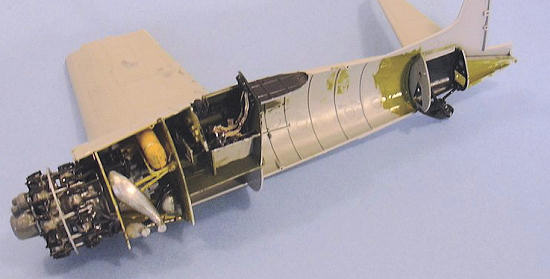 The cockpit makes up
into an impressive assembly, to the degree that most modelers who are not
resinaholics will be opting to spend the money for any aftermarket resin cockpit
on a second kit. As stated above, the cockpit really benefits from use of the
Eduard multi-part photoetch seatbelts, which is what I used here. I think the
photoetch instrument panel with the filmstrip instrument faces is more accurate
looking than the clear plastic parts.
The cockpit makes up
into an impressive assembly, to the degree that most modelers who are not
resinaholics will be opting to spend the money for any aftermarket resin cockpit
on a second kit. As stated above, the cockpit really benefits from use of the
Eduard multi-part photoetch seatbelts, which is what I used here. I think the
photoetch instrument panel with the filmstrip instrument faces is more accurate
looking than the clear plastic parts.
I assembled the wings to the fuselage halves before further assembling the fuselage, so that I could work on the joint from both sides of the fuselage part, which insured a good fit without having to use any gap-filler.
The wings can be assembled folded, and Trumpeter provides all the parts necessary to do this and have a good-looking result. If you are going to spread the wings, I recommend that you attach the outer wings to the center section before assembling the upper and lower halves, and reinforce that joint with Evergreen sheet inside.
I elected to assemble the control surfaces in the neutral position since I know the control stick is spring-loaded on a Bearcat and this is the position they normally take when the airplane is parked on the ground.
I also decided not to attach the drop tank or the underwing ordnance, since I was making a peacetime airplane, and these items spoil the lines of the finished model. (I also broke one of the shackles for the drop tank, which would have resulted in a very weak assembly, which confirmed my decision for me.)
| COLORS & MARKINGS |
 Painting:
Painting:
The model was given an overall coat of Xtracrylix “Glossy Sea Blue,” which I think is the best GSB out there in terms of color. When that was dry, I applied a coat of Xtracrylix Gloss Varnish.
Decals:
Beware that Trumpeter’s decal placement guide shows the red-and-white stripe and fuselage national insignia too low. Bill Larkins’ photo clearly shows the stripe was just under the horizontal stabilizer, so that it was entirely on the lower rudder, with its lower edge even with the bottom of the rudder. This is also the position where the two stripes fit best, so ignore the incorrect decal placement drawing.
| FINAL CONSTRUCTION |
When the decals had set, I gave the entire model a coat of Xtracrylix Satin Varnish. I then assembled the landing gear, and attached the propeller and the canopy in the open position after unmasking it. I lightly weathered this well-maintained airplane with some exhaust staining on the fuselage.
| CONCLUSIONS |
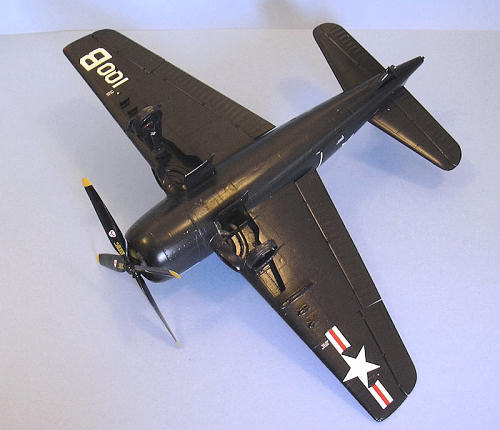 I think this is
Trumpeter’s best kit to date. The only complaint I have about it is really not
a complaint, that they did not have enough information to do the decals for the
wings correctly. Other than that, this is a well-designed kit that assembles
without difficulty and results in an accurate model of one of my favorite
airplanes. It looks great sitting next to the Wildcat, Hellcat, and Avenger,
near the Fisher Panthers and Cougars. I am sure there will be more than one of
these in the collection.
I think this is
Trumpeter’s best kit to date. The only complaint I have about it is really not
a complaint, that they did not have enough information to do the decals for the
wings correctly. Other than that, this is a well-designed kit that assembles
without difficulty and results in an accurate model of one of my favorite
airplanes. It looks great sitting next to the Wildcat, Hellcat, and Avenger,
near the Fisher Panthers and Cougars. I am sure there will be more than one of
these in the collection.
Thanks to Stevens International for the review kit.
April 2008
If you would like your product reviewed fairly and quickly, please contact me or see other details in the Note to Contributors.